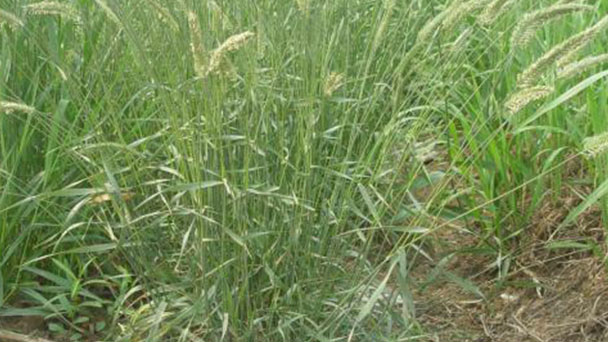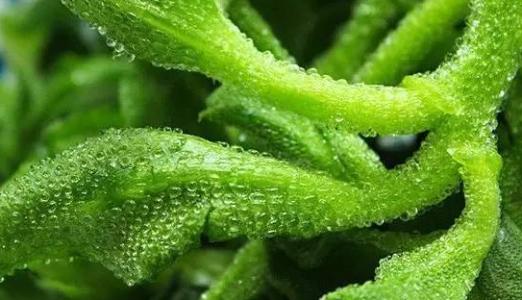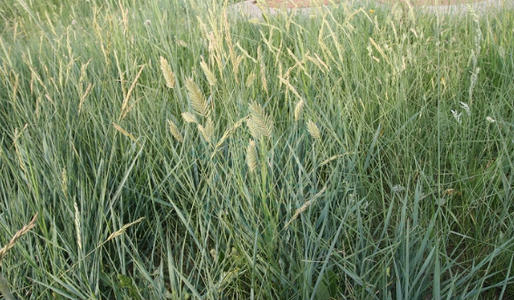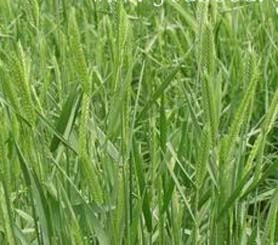Crested wheatgrass (Agropyron cristatum) profile
Written by Maggie
Mar 17 2021

Crested wheatgrass (Agropyron cristatum) is a perennial xerophytic grasses of the Gramineae family, which is one of the most important forages in arid regions of temperate zone.
Crested wheatgrass can grow on dry meadows, hillsides, hills and sandy land. Because of good quality, rich nutrition, palatability, all kinds of livestock like to eat; And because of the early return to green, Crested wheatgrass can provide green feed for grazing livestock earlier.
Crested wheatgrass especially has the characteristics of drought resistance, cold resistance, grazing resistance and more fertile, etc., which plays an important role in the replanting of grazing land and the establishment of dryland artificial grassland. Crested wheatgrass is also a good soil and water conservation plant and a sand-fixing plant because of its whisker, dense, sand-gathering and deep roots.
Crested Wheatgrass picture

Morphological characteristics of Crested Wheatgrass
Crested wheatgrass is a cold-season perennial herb with sparse stems pubescent or glabrous above adjacent inflorescences, 20 -- 60(75) cm tall, sometimes tillers transverse or descending to 10 cm in rhizomes.
Leaf blade of Crested wheatgrass is 5 -- 15(20) cm long and 2 -- 5 mm wide, rather hard and coarse, often entwined, upper veins strongly raised into longitudinal furrows, veins densely covered with minute short bristles. Spicate is stout, rectangular or slightly narrow at both ends, 2-6 cm long, 8-15 mm wide; Spikelets are closely parallel in two lines, neatly labyrinthian, containing (3)5-7 florets, 5-9 (12) mm long; Spikelets are navicular, ridges with dorsal intervene pilose, first glume 2 -- 3 mm long, second glume 3 -- 4 mm long, awns slightly shorter than glume; Lemma is densely pubescent or conspicuously sparsely pubescent, apically short awns 2-4 mm long; Lemma ridges with short bristles.
Most Crested wheatgrass are cross-pollinated polyploids, which are usually divided into two types: erect and rhizome. Except for a few species with particularly well-developed rhizomes, Crested wheatgrass has good seed setness and high seed yield and quality. Crested wheatgrass with terminal spikes, spikelets containing multiple florets, spikelets sessile, solitary (few in pairs) apperessing to the cob.
Crested wheatgrass has roots that extend down and across. Culms are solitary or caespitose, erect, 40 -- 100cm tall, with 3 -- 5 nodes, glabrous glabrous, or densely pilose under inflorescence. Leaf sheaths are smooth glabrous, or margin ciliate when young; Ligule is membranous, truncated, 1-1.5mm long; Leaf blade is 5 -- 30 x 4 -- 7mm, flattened or indentured, upper and margin scabrous or pubescent, lower smooth or slightly scabrous.
Spicate of Crested wheatgrass is erect, 10 -- 15 (-24) x 10 -- 17mm, grayish green; Spikelet is pubescent, nodes and margins villous, internode length 3-7mm, base up to 20mm; Spikelets are usually 2-3, sparse 1 or 4 on each node, 10 -- 20mm long, with 4 -- 7 (-10) florets; Coachlets internode length 1-1.5mm, adnate short hairs; Glume of Crested wheatgrass is shorter than spikelet, linear-lanceolate, apex narrow as awn, not covering base of 1st lemma, with inconspicuous 3 veins, upper half scabrous, margin ciliate, 1st glume shorter than 2nd glume, 8 -- 15mm long; Lemma is lanceolate, margin membranous, apex acuminate or with hairs 1 -- 3mm long, dorsal with 5-veined, pubescent or upper half glabrous, basal disc pubescent to 1mm long, 1st lemma 8 -- 10 (-14) mm, palea equal to lemma, apex often 2-lobed, upper ridge ciliated; Anthers are 3.5 -- 4mm long.
Ecological habits of Crested wheatgrass
Adapted to semi-humid to arid climates, Crested wheatgrass grows on arid grasslands or desert grasslands. Natural Crested wheatgrass rarely forms pure vegetation and is often mixed with other grasses, carex, non-grasses, and shrubs. On dry grasslands, hillsides, hills, and sandy lands.
Crested wheatgrass is especially resistant to drought, cold, grazing and high yield. Most species are adapted to semi-humid climate and grow in arid steppe and desert steppe.
Ecological environment: often born in the sandy land, plain green states and mountain grassland belt.
The way Crested wheatgrass propagates
Crested wheatgrass is propagated by seeding.
1) Sowing time: spring and summer can be sown.
2) Sowing amount: 15-22.5 kg per hectare.
3) Sowing method: drill or broadcast sowing.
4) Sowing depth: because the seeds are small, sowing should be shallow, covered with soil of 2-3 cm.
Variety classification of Crested Wheatgrass
There are 100 to 150 species of Crested wheatgrass in the world, most of which are adapted to semi-humid to arid climates and grow on arid steppes and desert steppes.
Related to the type of Crested wheatgrass
Species related to "Crested wheatgrass agropyron cristatum (L.) Gaertn." are:
Crested wheatgrass (Variety) Agropyron cristatum (L.) Gaertn.var. pectinatum (M. Bieb.) Roshev. Ex B. Fedtsch.
Multi-flowered Crested Wheatgrass (Variety)Agropyron Cristatum (L.) Gaertn.var. pluriflorum H. L. Yang
Crested Wheatgrass (Original Variety) Agropyron Cristatum (L.) Gaertn.var. cristatum
Maosa bears Csted wheatgrass (Variant)Agropyron Desertorum (Fisch.) Schult. Var. Pilosiusculum (Melderis) H.L. Yang
Csted Wheatgrassagropyron Desertorum (Fisch. Ex Link) Schult.
Csted wheatgrass (original variety) Agropyron desertorum (Fisch. Ex Link) Schult. Var. desertorum
Rhizome Crested wheatgrassAgropyron michnoi Roshev.
Agropyron mongolicum Keng
Agropyron mongolicum Keng var. mongolicum
Agropyron mongolicum Keng var. villosum H. L. Yang
Lemma Crested wheatgrass (variant) Agropyron sibiricum (Willd.) beauv.form. Pubifiorum Roshev.
Siberian Csted Wheatgrass (Original Variation) Agropyron sibiricum (Willd.) beauv.form
Siberian Csted wheatgrassAgropyron sibiricum (Willd.) P. Beauv.

Subspecies species
Crested Wheatgrass (General Botany)
Agropyron cristatum (Linn.) Gaertn. in Nov. Comm. Acad. Sci. Petrop. 14: 540. 1770; Gramineae 416. Graph 347. 1959. Chinese Higher Plants 5: 81.Picture 6992. 1976. -- Bromus Cristatus Linn. Sp.pl. 78.1753.
The spikelets of this species vary greatly in that the glumes and lemmas described above are densely pubescent, the lemmas are pubescent and the glumes are almost smooth and glabrous, or the lemmas are somewhat smooth and glabrous and the glumes are almost pubescent.All of them are now considered as the range of variation of this species and should be paid attention to in identifying this species.
Agropyron cristatum (Linn.) gaertn.var. pluriflorum H. L. Yang, Plant Research 4(4) : 88. 1984.
The inflorescences of this variety are clearly stout, long and broad, ovate-lanceolate, with a widest point of 2-2.5 cm; Spikelets bearing 9 -- 11 florets, 8 -- 18 mm long and distinct from the original variety. Produced in Inner Mongolia (Xilingol League). Born in the grassland and the wasteland. The type specimens were collected from Xilin Gol League, Inner Mongolia.
Agropyron Cristatum (Linn.) Gaertn.var. pectiniforme (Roem. et Schult.) H. L. Yang, Comb. Nov. -- Agropyron Pectiniforme Roem. et Schult. SYST.758. 1817. -- Agropyron arinarium W. Wang et al., Skv.nom. Nude., Liu Shen 'e et al., Northeast China Plant Index 478.Graph 175:6 1959. The main characteristic of this variety is that the glumes and lemmas are all smooth and glabrous or sparsely bristled with 0.1-0.2 mm short bristles. Western production of northeast, Inner Mongolia, Hebei, Qinghai, Xinjiang and other provinces. Born on the slopes of arid regions. The type specimens were collected from the lateral Caucasus.
The distribution of crested wheatgrass
Crested wheatgrass is mainly distributed in arid grassland areas of Heilongjiang, Jilin, Liaoning, Hebei, Shanxi, Shaanxi, Gansu, Qinghai, Xinjiang and Inner Mongolia provinces in China.
Crested wheatgrass is distributed abroad in Europe, Siberia of Russia, Central Asia and Mongolia.
The use of crested wheatgrass
Environmental value
Crested wheatgrass has the characteristics of drought resistance, cold resistance, grazing resistance and more offspring, and plays an important role in the replanting of grazing land and the establishment of dryland artificial grassland. Crested wheatgrass is also a good soil and water conservation plant and a sand-fixing plant because of its whisker, dense, sand-gathering and deep roots.
Feed effect
Natural Crested wheatgrass rarely forms pure vegetation and is often mixed with other grasses, carex, non-grasses and shrubs. Because of good quality, rich nutrition, palatability, all kinds of livestock like to eat;
And because of the early return to green, can provide green feed for grazing livestock earlier. It has the characteristics of drought resistance, cold resistance, grazing resistance and more offspring, and plays an important role in the replanting of grazing land and the establishment of dryland artificial grassland.
Crested wheatgrass is an excellent forage, which is preferred by horses and sheep when fresh, as well as cattle and camels. It has good nutritional value and is a medium fattening feed.
Use value
Crested wheatgrass is soft and has high nutritional value. It is preferred by horses and sheep when they are young, as well as cattle and camels.The digestibility and digestible nutrients of ruminant fed with Crested wheatgrass were also higher. Crested wheatgrass is an excellent natural herbage in arid steppe area.Its seed yield is high, easy to collect, germinating ability is strong. Therefore, many places have been introduced and cultivated, and become an important cultivated forage grass, both grazing and cutting grass. Single or mixed with leguminous forages yield 1500 kg of hay per hectare or 1999.5 kg for the taller. Winter branches and leaves are not easy to fall off, and can still be grazing.

Latest Updated
- Benefits of Bugleweed - 7 Science-backed Health Benefits
- Bugleweed Dangers & Side Effects - Is It Poisonous?
- How to Plant Evergreen Trees - What You Should Know
- When to Plant Evergreens - Grow Guide for Evergreen Trees
- 12 Wonderful Evergreen Shrubs for Your Garden
- 12 Popular Evergreen Plants with Pictures for Beginners
- When And How To Prune A Lilac Bush Like a Pro
- How to Grow & Care for Lilac Vine (Hardenbergia Violacea)
- Japanese Lilac Tree (Syringa Reticulata) Care & Propagation Guide
- Shumard Oak Pros and Cons - What to Know
Popular Articles
- Winter maintenance of Antirrhinum Majus
- How to Grow Terminalia Mantaly Tree
- How to Grow and Care for Crossostephium Chinense
- How to grow Antirrhinum Majus in spring
- Peristeria Elata (Dove Orchid) Profile: Info & Care Guide
- Underwatered Snake Plant (Sansevieria Trifasciata) - Signs And How To Fix
- How to Care for Brazilian Jasmine Plant (Mandevilla Sanderi)
- How to Grow & Care for Graptopetalum Purple Delight in Summer
- Rosa Chinensis (China Rose): Plant Growing & Care Tips
- How to Care for Baby Sun Rose (Aptenia Cordifolia)